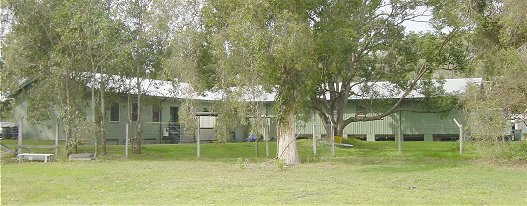Brisbane played a pivotal role as a strategic hub for Allied communication networks during World War II, hosting critical radio transmitting and receiving stations that facilitated the exchange of intelligence, operational orders, and coordination across the Pacific theatre. Managed by the United States Army Signal Corps, these facilities were complemented by independent networks operated by the Royal Australian Air Force (RAAF), Australian Army, Royal Australian Navy (RAN), and the Netherlands East Indies government-in-exile. This article provides an overview of the network’s sites, functions, and management.
Key Sites and Their Roles
Capalaba (Now Birkdale):
The United States Radio Receiving Station at Capalaba, selected for its damp and soggy terrain ideal for radio sensitivity, became the backbone of Pacific communications. Equipped between June and September 1942, it connected to the Signal Office at Base Section 3, Somerville House in South Brisbane. Capalaba’s rhombic antennas enabled direct communication with San Francisco, which was then relayed by landline to Washington, D.C.
- Infrastructure: The station featured reinforced brick construction, designed to withstand bomb blasts, with cables running beneath the floor for added security.
- Operations: Capalaba functioned exclusively as a receiving station and ensuring seamless communication.
Redland Bay:
A complementary transmitting station at the Redland Bay Golf Course worked in tandem with the Capalaba receiving station. The transmitting and receiving stations were separated to avoid radio interference

Hemmant:
Located at Young’s Road, Hemmant housed a US radio transmitting station that supported Capalaba. A brick building from the era remains on-site, now used as a house, serving as a physical reminder of its wartime role.
Rocklea:
Rocklea hosted transmitting and receiving stations on farmland south of Sherwood Road. These sites, located near Oxley Creek and Stable Swamp Creek, were initially intended for Dutch use but were ultimately used by the US Army Signal Corps. No physical structures remain, but the site’s history underscores Brisbane’s strategic importance.
Management by the US Army Signal Corps
The US Army Signal Corps was responsible for establishing and maintaining these facilities, ensuring seamless communication across the Pacific. Key management strategies included:
- Strategic Site Selection: Locations were chosen based on geographic and environmental factors that enhanced radio performance, such as damp soil and minimal electromagnetic interference.
- Robust Infrastructure: Sites were fortified against potential enemy action, with reinforced walls and secure cable routing.
- Interconnected Network: Stations were linked via rented PMG cable pairs and redundant systems to mitigate disruptions.
Comms support for the Netherlands East Indies Government-in-Exile
After the Americans left the Dutch took over Camp Columbia and of course the Brisbane radio facilities were also integral to the operations of the Netherlands East Indies (NEI) government-in-exile, which had relocated to Australia after the Japanese occupation of their homeland. While there is no conclusive evidence that the Dutch used the Rocklea sites, it is speculated that they may have operated independent radio networks. Key aspects of their operations included:
- Support for Resistance Efforts: Communication infrastructure in Brisbane allowed the Dutch to coordinate resistance and intelligence activities in occupied territories.
The Dutch also had radio operations at Batchelor in Northern Territory and Craigieburn in Victoria.
It is unknown what the radio operations in Camp Columbia existed off. The only reference is a teleprinter connected to the station in Craigieburn. The question is what infrastructure was used for that, Australian telecoms or US Army equipment? Maps indicate that here is a ‘Radio Camp’ area at the top of the hill at Camp Columbia.
Challenges and Collaboration
Security and Redundancy:
To protect the network from potential enemy attacks, significant measures were taken to fortify the sites. The separation of transmitting and receiving functions reduced the risk of interference and enhanced reliability.
Independent Networks:
The collaboration among Allied forces, including the Australians and the Dutch, was critical, though each maintained its own independent communication networks to suit operational needs.
Legacy
Today, remnants of Brisbane’s wartime communication network, such as the brick building at Hemmant, stand as reminders of the city’s strategic significance during World War II. The city’s radio communication facilities represent a remarkable feat of engineering and collaboration, bridging vast distances and diverse military efforts to secure victory in the Pacific theatre.
With thanks to Peter Dunn, Jack Ford and Brian Sinclair
